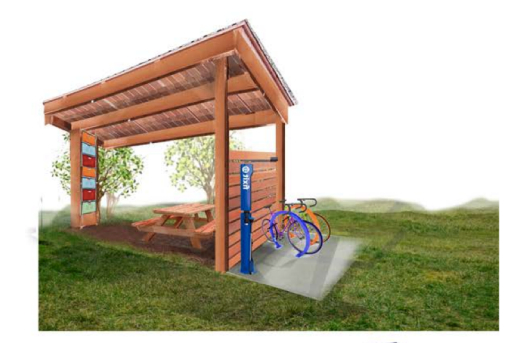
Looking to take bicycle tourism to the next level — and to solidify the direct connection between bicycling and economic development — Oregon State Parks wants to create a network of covered bike facilities they say will “redefine the cycling experience.” The Oregon Parks and Recreation Department (OPRD) call these facilities “bike pods” and “bike hubs” and if all goes according to plan there will eventually be 19 of them throughout the state, with the first one set for construction this summer.
We first reported on the “Bike Pods of Oregon” project a few weeks ago after OPRD submitted a grant application to ODOT’s Connect Oregon program. OPRD is hoping to secure $348,000 from the lottery-backed funding program (the pods project will cost a total of $435,000).
According to the application (PDF), there will be two types of facilities: bike pods and bike hubs. Here’s how they describe each one:
“The deluxe overnight ‘Bike Pods’ will be constructed to serve the long distance touring cyclist, while the day use ‘Bike Hubs’ will be constructed to best serve the needs of the day use cyclist whether for recreation or cycling.”
And here’s what they’ll look like:
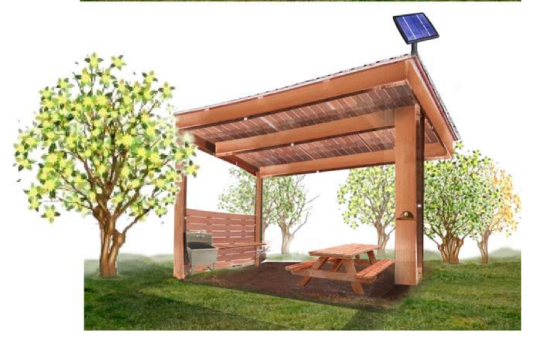
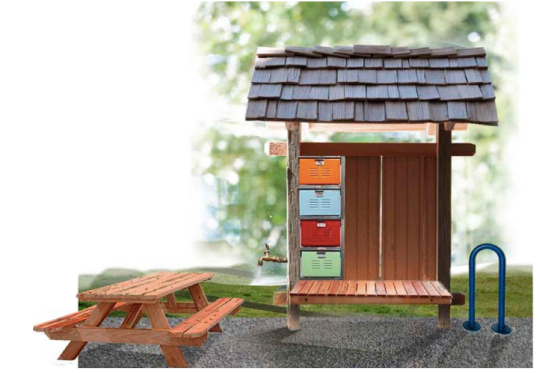
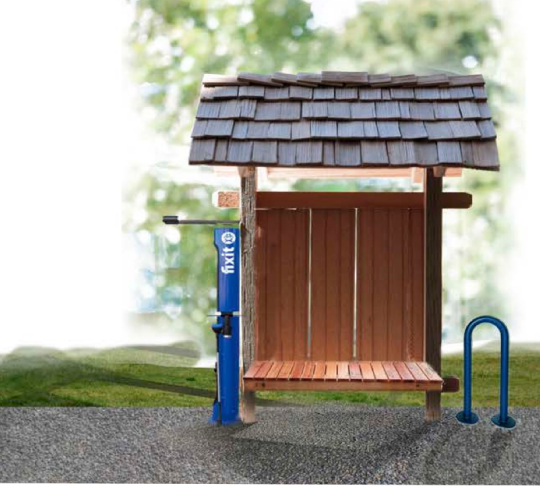
And they even thought of food storage:
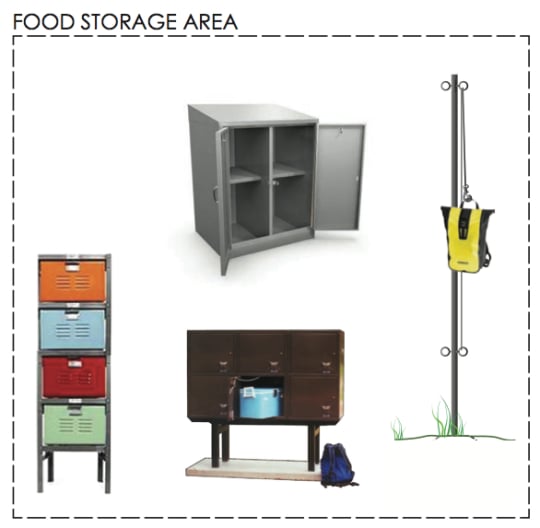
A map included in OPRD’s grant application shows plans for 12 deluxe bike pods and 7 basic bike hubs:
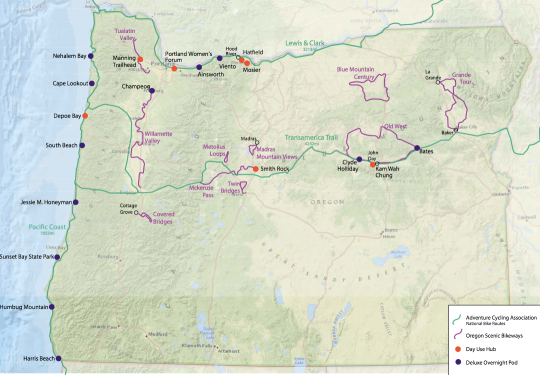
The City of Mosier has been a leader in supporting this effort and they appear to be the first city that will receive on the hubs. They’ve already budgeted for its repair and maintenance in their 2014 budget. A pod at Champoeg State Park is also in advance planning stages.
OPRD says these plans are key to meeting the growing demands of State Parks users who arrive by bicycle. In 2011, an OPRD survey found that 10,221 people used their “hiker-biker” campsites. That number jumped to 11,186 in 2012 and OPRD is preparing for an estimated jump to 20,000 users by 2017.
“This project will cater to the growing number of cycle tourists of various physical abilities in Oregon and bolster local communities’ economies via introducing cycle tourists to their towns.”
— OPRD grant application
Throughout their application they make a strong case that the rise in bicycle tourism across the state is an important economic engine for both the parks and the communities around them. A recent survey by Travel Oregon showed that bike-related tourism accounts for $400 million of our state’s $9 billion tourism industry.
“Additional amenities are essential,” says OPRD, “for improving cyclists’ experiences on Oregon’s roads and trails and to capture the attention of the 43 million Americans who participate in cycling as a form of recreation or travel… ‘Bike Pods of Oregon’ provides a critical link to this sustainable sector of Oregon’s economy”
Oregon sees this program as a way to prop up small towns where the economy needs a boost while remaining competitive as a leader in bicycle tourism. From the application: “Recreational Cycling is part of Oregon’s growing tourism industry, an opportunity for struggling communities to capitalize on their locations near stunningly beautiful scenery and public lands.”
As you can see in the design mockups, the pods and hubs offer services like bike repair stands, water refill stations, electrical outlets, shelter from the elements, maps, food protection and secure gear lockers. The thinking is, if people (and their stuff) are more comfortable, they’ll be more likely to stay in a community longer and ultimately will spend more money and be more likely to tour by bike again.
OPRD’s application includes letters of support from Thunder Island Brewing Company (in Cascade Locks) the City of Mosier, the Wasco County Board of Commissioners, a Tillamook County Commissioner, ODOT’s Historic Columbia River Highway Advisory Committee, and Cycle Oregon.
Stay tuned: We’ll let you if they win this grant.


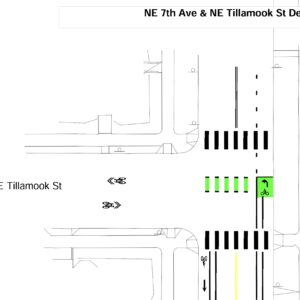

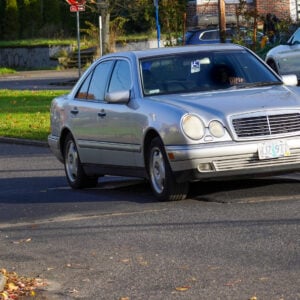
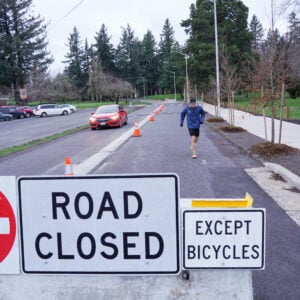
Thanks for reading.
BikePortland has served this community with independent community journalism since 2005. We rely on subscriptions from readers like you to survive. Your financial support is vital in keeping this valuable resource alive and well.
Please subscribe today to strengthen and expand our work.
This is great! I’ve enjoyed my bike-based stays at Champoeg, but keeping the phone charged was a challenge. And with the western Gorge now opened up to free-of-freeway touring, I expect to use the Ainsworth or Viento pod soon after it opens too.
No words for how cool this looks; time for some coast range touring!
This is a great idea. I hope the people in the Gorge don’t mind a lot more cyclists out there (spending money).
I’d vote to keep the bikes immediately next to the sleeping area. I don’t need something blocking my view of my bicycle, as well as acting as a noise shield, if something shady is going own with it.
Yes to a visual connection between me and my bike.
A roof over my bike’s head would be nice, too. For the bike, and for me, when I’m rummaging around in panniers, etc.
Ted Buehler
I think more infrastructure is a good thing. Quality infrastructure is a better thing. Another yes on putting the bike under cover of the “bike pods”, and to building and infrastructure that allows for future growth expansion is the best thing.
Agreed. No cover for the bicycle was the first thing that came to mind when I saw the picture on the front page.
I’m with you. When traveling by bike, my bike is the first thing I want to see when I crack open my eyes in the morning. It’s the one constant in the scenery, and the only thing standing between me and hobohood when on a journey.
Need LOTS of these. The future!
Great concept! Actually, Mosier would benefit from an o’nite facility. Hope they can upgrade at some point.
Another place suffering from lack of public bike camping facilities is The Dalles. I’ve looked for years & not found anything suitable. Mayer State Park at Rowena would be a good location. I’d be happy to pay a small fee for something there.
Closest thing to the Dalles is Deschutes State Park, though admittedly it’s a few miles of gravel and a few hundred miles away. Camping is $5 for bikers in the “primitive” campsite area. Open year-round, with hot showers available about half the year (usually open by the end of March). Or, for free you can ride 4-8 miles up the trail and camp at one of the BLM floater/boater sites along the river.
I think Columbia Hills State Park, just across the river from The Dalles, may also have a few hiker-biker sites, but last I looked it didn’t appear too promising. Maybe they’ve improved it since. Access is pretty easy, since there’s a decent sidewalk along the east side of the bridge.
yes, Columbia Hills State Park does claim to have primitive hiker/biker sites:
http://www.parks.wa.gov/489/Columbia-Hills
haven’t stayed there but it looks like a lovely spot to spend the night – nice river views, and only a dozen or so campsites.
Deschutes State Park on the Oregon side is about 15 miles east of the Dalles.
I’ve stayed at Columbia Hills. We were car camping but used one of their sites. It’s very nice. There’s a wind wall, a concrete slab, a picnic bench and a fire pit. A cool place to camp with lots to explore, including a lake, awesome rock climbing/scrambling, and even some native american drawings down near the riverside.
I’d rather the money be spent on building more trails so that we can get to more destinations by bicycle ( safely ) in the first place.
Scott, I share your sentiment in principal, but $400k will buy you *maybe* a mile of trail, at best.
Would love to see these on the scenic bikeways! As I look at the maps I always wish there were more camping options for our family to do those routes but it seems they are made more for longer recreational rides more so than overnighters. For example there are a couple campgrounds near the Covered Bridges bikeway but nothing ON it. It would be so great to park in Cottage Grove, ride out the trail, camp, then ride back!
Also, thinking about Smith Rick this summer…notice that one is marked as day use. It seems perfect for an overnighters- 37 mile ride from Sisters, camp, and back next day (or two).
What keeps general campers and hikers from staying at these?.. I would rather have small, inexpensive campsites with a faucet,single plug and small table with a built in cover .make them along known bike paths.. make them compact and cheap and put a bunch throughout the state…don’t need food lockers,bike fixit racks,expensive roofs,maps, cement and all of that expensive stuff..people have that already worked out…better to skip that and put in a small building pit toilet with sink,plug and fold up table that locks and can be dropped on location…think CHEAPER ,more plentiful and functional…survey a bunch of cyclists BEFORE building and ask their needs..
Jeff, I disagree. First of all, these overnight pods appear to be destined for OSP’s with hiker/biker campsites. These are available only to people that arrive by foot or bike – and while i guess you could park outside the park and schlep your gear in I’ve never seen this. I find the proposed amenities a perfect fit for my bike touring needs.
The State Parks with hiker/biker campsites already have showers/toilets (albeit a short walk away), and a water tap – but they don’t have gear storage lockers, which is an inspired addition as the critters can be assertive. To charge a phone you can go hang out around the restrooms (ugh) , so adding electrical is kind of nice. Having a floor pump is great – a frame pump makes it challenging to top off 90psi+ tires, and makes for good flat prevention. Finally, a covered area with picnic table is – especially on the Oregon Coast – likely to be used…every…freakin’…night. It’s wet out there, and avoiding getting drenched while you’re eating dinner is a big plus.
I think you have a different concept of who the users of these should be, but I can tell you from my experience and people I’ve toured with, these are very well thought out by Oregon State Parks to serve the needs of cyclists who are on a self-supported tour.
Cost each is what?
…looks like they have been reading my hand written notes that I leave in the suggestion boxes next to the iron ranger at most hiker biker camp sites!
I would add to the excellent list above:
– install camping hammock hook (2) and additional post (2) so that each site has a two hammock capacity
– install a communal pan rinse area and drain board in more active sites (Cape Lookout type) vs. standing in mud at the water point
– folding massage table (may be better for phase 2)
And remember that a lot of local boy scouts and troops are looking for projects to earn merit badges and support the outdoors…hook up with them and place the construction plans on line with hardware list for ease in local fabrication.
Having been mugged by a raccoon when I didn’t hang the food bag high enough, I have to say the food storage is great.
Yes. Food storage is most welcome. Fort Stevens, are you listening!? The raccoons there are fearless, they attack in packs, and they NEVER SLEEP!
The chipmunks at Cape Lookout have evolved opposable thumbs. They can get into anything, and they will just sit there and dare you to try and stop them. Fortunately, sometime in the last few years, Cape Lookout got some fancy new food lockers.
The tall post with a cable to hang your bag on is interesting.
-Cota
Sojnds great, hope each and every cyclist winds up paying for these instead of the state. Then I say go for it.
That idea will be really successful, like toll booths on the Columbia were.
As soon as all the pedestrians start paying for the sidewalks!
So you’re saying this is not a good use of lottery revenues? Or hiker/biker site users aren’t entitled to better facilities than they have now?
For fee comparison, A $5 per person hiker/biker fee gets you a fire ring, picnic table, communal water tap, and a place to pitch your tent. A full RV site for $31 gets you electrical, a giant asphalt pad to park your behemoth, a dump station for your sewage, water hook-up, plus the fire ring and picnic table – all for as many people you care to bring along.
Kathy, hi. This is 2014, WWII has ended and the subsidization of oil based infrastructure can end too. Maybe all the sick people can pay for the hospitals until its your turn and all the kids can go work in sweat shops so they can pay for the schools, too. Kathy, hi. This is 2014.
I applaud your spirit of fairness and hope that you’re following through by paying the per-incident cost for the dispatcher and police officer every time you call 911 to get those darn kids off your lawn. 😉
$23K _Each_. For reference, we live in a 280 sq. ft. cabin with R-23 insulated walls, R-30 roof and floor, locking door, windows, plumbing, power and wood burning stove. And assessed at $10K by the county. I’ve probably got $5K in materials in it, and when complete, to be fair, it will be assessed at $25K according to the local assessor. OSP is either being ripped off big time, wasting money, or I need to move down there for the duration of the construction.
Shelter from the rain for the charging spot would be welcome to protect cell phones, battery chargers, etc. Great to see the ideas we discussed at last year’s bike touring workshop getting legs!
This is a totally sick Idea Love it!
Thank you for all of your comments. As some of you have already mentioned, our schematic designs were based heavily on feedback from hiker/biker surveys.
We are currently designing test pods at Bullard’s Beach, Milo McIver, and Champoeg. They should be installed by this summer. Please keep an eye out for further developments and continue commenting as we are eager to hear more of your ideas.
Might be time to mention Warmshowers.org as another method of securing adequate housing and more for touring cyclists. I heard about it here a couple years ago and have had many wonderful guests in my home since then, many of whom are like family now and KEEP COMING BACK! Yee gods. Can’t wait to try it out as a cyclists myself.
Is the outrageous cost because we’ve been so lawyered up that volunteers can’t do anything for fear of someone being sued because they got a splinter from a table? I like the idea of using these as Boy Scout projects, or community projects or service club projects or bike club projects. Someone needs to revise these plans and make them simpler and cheaper to build and place them more numerously on established bike routes. Ever had to pee when taking the Willamette Valley Scenic Bikeway? Good luck!
Oregon State Parks, they”re the best!
Please pray with me that these will not succumb to vandals! This is a great idea, but I fear them standing all alone out there!
I think the Hubs (the ones installed at hiker/biker campsites) should fare pretty well – or at least no worse than anything else at the State Park – since there’s OSP personel on the premises at most hours. The ones that are day-use areas might get hit pretty hard, though, under the cover of darkness. Let’s hope not.